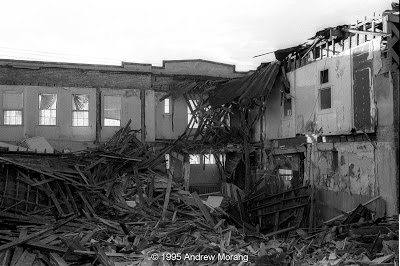Dear Readers, good news! This big 1890s-vintage Queen Anne-style house at 916 Walnut Street in Vicksburg is being renovated and repaired.
In past decades, the building was used as an Elks Lodge, but the organization left the building many years ago. For at least two years, periodically a condemnation notice from the City inspector was posted on the building, but afterwards the sign would be gone. Was the owner repairing the structure? It certainly did not look like any work was ongoing.
Finally, in October or November of 2017, serious renovation began. Vicksburg developer Daryl Hollingsworth (an energetic fellow - he also ran for mayor) bought the huge old house and set about stabilizing it and cleaning out interior debris. Mr. Hollingsworth generously showed me around and let me take pictures.
The house has been so abused over the decades, it is hard to tell how the rooms were used. Was this once the main parlor?
Night club wallpaper on the old plaster walls! Notice the wood lath. Mr. Hollingsworth said he will have the damaged areas replastered the right way (
i.e., with plaster, not covered with sheetrock).
The stairs were oddly narrow for what was once a magnificent house.
Upstairs: more funky wallpaper and damaged walls that had been covered with cheesy paneling of the type you might have seen in a 1970s den. That garbage paneling was popular in the 1970s and 1980s, even though everyone knew it was just plywood.
A beautiful fireplace with its original glazed tiles survived on the second floor. These were small fireplaces intended to burn coal on a metal pan. Vicksburg was a railroad town, so coal was readily available. The problem with coal was that embers sometimes went up the chimney and could land on the roofs of nearby houses. Resisting fire is a main reason that fireproof asbestos shingles were so popular in the early 20th century.
This well-lit room faces the north and west, with a view of the Yazoo Canal. This fireplace also survived semi-intact with its cast-iron trim cover, but only a few of the decorative tiles remain. The square hearth tiles are identical to the ones in my 1920s house.
Another place to explore: a narrow stair leads to the attic. Notice the lath on the walls where damaged plaster has been removed.
The attic has plenty of headroom. Originally, slate shingles would have been nailed to the dark wood horizontal boards that span the roof joists. I know the shingles were slate because the tower still has its slates (see photograph 2 above), while the rest of the house has been re-roofed. A friend on Baum Street had such a slate roof on his house - no roofing paper or decking, just slate tiles you could see from below. The slate lasts decades, but after a century or so, weathering takes its toll and the tiles begin to crack or get thin. Also, after a century, the the nails fail (when done the right way, slate and tile roofs
must use copper nails - if your roofer tries to sell you galvanized nails, fire him). This house on Walnut Street was re-roofed with new plywood decking laid above the 1890 boards.
Some original doors had been stored in the attic. They can be cleaned and hopefully used in the rooms below.
 |
| Jackson Street view west towards the Yazoo Canal. |
Let us take a quick look outside. This was once a fashionable neighborhood with other grand Queen Anne houses. The parking lot south of 916 Walnut (see photograph 1) almost surely had a house on it, but it has been gone for decades. When Vicksburg was platted, Jackson Street was envisioned to be the main east-west thoroughfare, the business center of the city. Therefore, it had a grand boulevard design, with a grass center strip. Commercial businesses instead developed along Clay Street, leaving Jackson Street relatively quiet, and, I assume, mostly residential. The upper part of Jackson Street still has its brick paving and grass median; very nice. Lower Jackson Street, joining Washington Street, has been covered with pavement and now looks like any other crummy tarred street.
In summary, it is welcome news that this house is being saved. Vicksburg has lost far too much of its historical architecture because of neglect, corruption, greed, lack of imagination, and misguided "urban renewal."
Photographs taken with a Fuji X-E1 digital camera, most with the Fujinon 14mm f/2.8 lens. All frames were tripod-mounted.
UPDATE Sep. 2, 2022. Renovations and repairs are still ongoing.














































